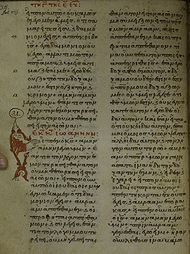Lectionary 239
|
New Testament manuscript |
|

Folio 15 verso
|
|
| Text | Evangelistarium † |
|---|---|
| Date | 13th century |
| Script | Greek |
| Now at | Glasgow University Library |
| Size | 26.6 cm by 20 cm |
Lectionary 239, designated by siglum ℓ 239 (in the Gregory-Aland numbering) is a Greek manuscript of the New Testament, on parchment. Palaeographically it has been assigned to the 13th century. Scrivener labelled it by 230evl. The manuscript has no complex contents.
The codex contains daily lessons for reading in Church from Easter to Pentecost. The lessons are taken from the Gospels of John, Matthew, Luke lectionary (Evangelistarium), with some lacunae at the end. The cover is from paper.
The text is written in Greek minuscule letters, on 112 parchment leaves (26.6 cm by 20 cm), in two columns per page, 27-36 lines per page. The rubricated initial letter for E with right hand making the orthodox sign of the cross. The error of itacism is frequent (especially interchange ε → αι). The nomina sacra are written in an abbreviated way.
On the last folio 112 verso it contains a grotesque twisted dragon ornament (in red and white coils). At the foot of the page in De Missy's hand (?): "Ex libris Caesaris De Missy, Berolinensis:— | Londini: Anno Domini 1748."
The lessons are numbered by modern hand (probably by de Missy).
The word before the bracket is the reading of the UBS edition, the word after the bracket is the reading of the manuscript. The reading of Textus Receptus in bold.
According to the colophon it was written in A.D. 1259. It has been assigned by the Institute for New Testament Textual Research to the 13th century.
...
Wikipedia
